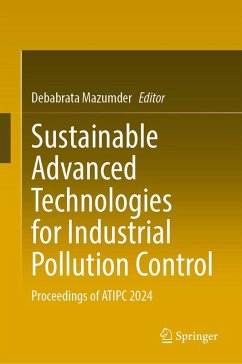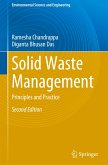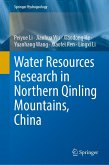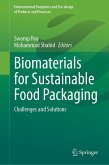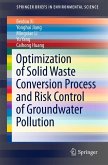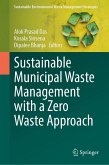Sustainable Advanced Technologies for Industrial Pollution Control
Proceedings of ATIPC 2024
Herausgegeben:Mazumder, Debabrata
Sustainable Advanced Technologies for Industrial Pollution Control
Proceedings of ATIPC 2024
Herausgegeben:Mazumder, Debabrata
- Gebundenes Buch
- Merkliste
- Auf die Merkliste
- Bewerten Bewerten
- Teilen
- Produkt teilen
- Produkterinnerung
- Produkterinnerung
This book constitutes peer-reviewed full-length papers contributed by the authors and tailored on various thematic areas of the 4th International Conference on Advanced Technologies for Industrial Pollution Control (ATIPC-2024). The main purpose of this book is to keep a record of quality publication dedicated to the 4th International Conference on Advanced Technologies for Industrial Pollution Control (ATIPC 2024). At the same time, it presents a collection of state-of-the-art research work/case studies in aforesaid thematic areas. Since all the thematic areas have been chosen uniquely…mehr
Andere Kunden interessierten sich auch für
![Sustainable Advanced Technologies for Industrial Pollution Control Sustainable Advanced Technologies for Industrial Pollution Control]() Sustainable Advanced Technologies for Industrial Pollution Control166,99 €
Sustainable Advanced Technologies for Industrial Pollution Control166,99 €![Solid Waste Management Solid Waste Management]() Ramesha ChandrappaSolid Waste Management190,99 €
Ramesha ChandrappaSolid Waste Management190,99 €![Water Resources Research in Northern Qinling Mountains, China Water Resources Research in Northern Qinling Mountains, China]() Peiyue LiWater Resources Research in Northern Qinling Mountains, China121,99 €
Peiyue LiWater Resources Research in Northern Qinling Mountains, China121,99 €![Biomaterials for Sustainable Food Packaging Biomaterials for Sustainable Food Packaging]() Biomaterials for Sustainable Food Packaging121,99 €
Biomaterials for Sustainable Food Packaging121,99 €![Optimization of Solid Waste Conversion Process and Risk Control of Groundwater Pollution Optimization of Solid Waste Conversion Process and Risk Control of Groundwater Pollution]() Beidou XiOptimization of Solid Waste Conversion Process and Risk Control of Groundwater Pollution38,99 €
Beidou XiOptimization of Solid Waste Conversion Process and Risk Control of Groundwater Pollution38,99 €![Synergizing Sustainability for Integrated Waste Management Synergizing Sustainability for Integrated Waste Management]() Synergizing Sustainability for Integrated Waste Management121,99 €
Synergizing Sustainability for Integrated Waste Management121,99 €![Sustainable Municipal Waste Management with a Zero Waste Approach Sustainable Municipal Waste Management with a Zero Waste Approach]() Sustainable Municipal Waste Management with a Zero Waste Approach121,99 €
Sustainable Municipal Waste Management with a Zero Waste Approach121,99 €-
-
-
This book constitutes peer-reviewed full-length papers contributed by the authors and tailored on various thematic areas of the 4th International Conference on Advanced Technologies for Industrial Pollution Control (ATIPC-2024). The main purpose of this book is to keep a record of quality publication dedicated to the 4th International Conference on Advanced Technologies for Industrial Pollution Control (ATIPC 2024). At the same time, it presents a collection of state-of-the-art research work/case studies in aforesaid thematic areas. Since all the thematic areas have been chosen uniquely without any similarity with other conferences, the book will definitely be an exclusive one. This book is intended for the researchers, academicians, and industry persons in the relevant field of study. It is expected that updated information in various thematic area will be available from the proposed book.
Produktdetails
- Produktdetails
- Verlag: Springer / Springer Nature Switzerland / Springer, Berlin
- Artikelnr. des Verlages: 89526085, 978-3-032-07961-9
- Seitenzahl: 406
- Erscheinungstermin: 15. Dezember 2025
- Englisch
- Abmessung: 235mm x 155mm
- ISBN-13: 9783032079619
- ISBN-10: 3032079616
- Artikelnr.: 75331483
- Herstellerkennzeichnung
- Springer-Verlag GmbH
- Tiergartenstr. 17
- 69121 Heidelberg
- ProductSafety@springernature.com
- Verlag: Springer / Springer Nature Switzerland / Springer, Berlin
- Artikelnr. des Verlages: 89526085, 978-3-032-07961-9
- Seitenzahl: 406
- Erscheinungstermin: 15. Dezember 2025
- Englisch
- Abmessung: 235mm x 155mm
- ISBN-13: 9783032079619
- ISBN-10: 3032079616
- Artikelnr.: 75331483
- Herstellerkennzeichnung
- Springer-Verlag GmbH
- Tiergartenstr. 17
- 69121 Heidelberg
- ProductSafety@springernature.com
Prof. Debabrata Mazumder did his bachelor’s and master’s degree in civil engineering from Jadavpur University in 1993 and 1996, respectively. He received his Ph.D. degree in civil engineering (environmental engineering specialization) from Bengal Engineering and Science University, Shibpur ( presently Indian Institute of Engineering science and Technology, Shibpur ), in 2004. He has a total 32 years of industrial, teaching, and research experience. He published more than 175 technical papers and 16 book chapters in various national and international journals and conference proceedings. He has co-authored 1 reference book and edited 3 proceedings books in the Springer Nature. He is Member of American Water Works Association (AWWA) and Member of International Water Association (IWA). He is also Life Fellow of Institution of Engineers (India), Institution of Public Health Engineers (India), and Indian Water Works Association (IWWA). He has become Professional Engineer [P.Eng. (India)], certified by Institution of Engineers (India) in 2025.
1.Water quality distribution in durgam cheruvu lake.- 1.2Monitoring of water quality variation trends in a coastal wetland system, a ramsar site: a gis and water quality index based assessment.-1.3 Efficiency evaluation of fe-cu composite adsorbent for arsenic removal.-1.4 Quality improvement of a piped water supply with high hardness and chloride by electro-dialysis process.-1.5 Assessment of attenuation potential of a fine-grained indian clay soil for lead (pb2+) removal with performing batch study and kinetic-isotherm modelling.-1.6 Artificial neural network (ann) modeling of fluoride adsorption by chloride-doped-polyaniline in a fixedbed column study.-1.7 Modeling and optimization of arsenic removal in presence of total organic carbon (toc) by iron functionalized reduced graphene oxide (frgo) .-2.1 Removal of methyl green dye by adsorption using nitrogen-doped graphitic carbon nitride.- 2.2 Combined carbon and nitrogen removal from synthetic wastewater in an mbhbr coupled with mbr.-2.3 Sulfuric acid-impregnated petai pod activated carbon for landfill leachate treatment: ann prediction modelling.-2.4 Machine learning-based performance evaluation and optimization of biological reactors for sewage water treatment.-2.5 Synthesis and application of ag+-htnt on br9 adsorption from wastewater.- 2.6 Phosphate adsorption from wastewater on the synthetic low-cost adsorbent synthetic-iron-oxide-merged-crushers-waste (siomcw).-2.7 Reuse implications of spent biosorbent in removal of dye .-2.8 Adsorptive removal of methylene blue and congo red in binary solute using raw rice husk as a low-cost adsorbent.-3.1The carbon footprint of an urban area: a case study on the l ward (kurla) of municipal corporation of greater mumbai.-3.2 The greenhouse gas emission of mumbai city.- 3.3 A study of the quality and effectiveness of environmental impact assessment (eia) in the context of indian active pharmaceutical ingredients (api) industry.-3.4 Design of a sustainable, modified concrete by partial replacement of cement using ground granulated blast furnace slag and limestone powder to reduce carbon footprint.-4.1 Influence of waste tyre derived material on shear strength of soil.- 4.2 Sorptivity of plasticized alkaliactivated concrete from waste.-4.3 Development of composite insulation board using high- density polyethylene caps of bottles for cavity wall applications.- 4.4 Physical and chemical characterization of various grades of natural fine aggregate and recycled fine aggregate.-4.5 Predicting e-waste trajectory: a comparative analysis.- 5.1 Forecasting solid waste generation and its composition in visakhapatnam: a case study.-5.2 Performance of batch studies on composting of kitchen vegetable waste.-5.3A sustainable strategy to control urban pollution from municipal solid waste management practice- a case study of smart city, newtown.-6.1The potential application of mercury-resistant bacterial strain (iitism24id) in mercury removal.-6.2Primary treatment of synthetic plastic waste materials.- 6.3Recovery of lithium from end-oflife mobile phone battery waste.-6.4Distribution of microplastics in semi-urban estuary water along the west coast of india.
1.Water quality distribution in durgam cheruvu lake.- 1.2Monitoring of water quality variation trends in a coastal wetland system, a ramsar site: a gis and water quality index based assessment.-1.3 Efficiency evaluation of fe-cu composite adsorbent for arsenic removal.-1.4 Quality improvement of a piped water supply with high hardness and chloride by electro-dialysis process.-1.5 Assessment of attenuation potential of a fine-grained indian clay soil for lead (pb2+) removal with performing batch study and kinetic-isotherm modelling.-1.6 Artificial neural network (ann) modeling of fluoride adsorption by chloride-doped-polyaniline in a fixedbed column study.-1.7 Modeling and optimization of arsenic removal in presence of total organic carbon (toc) by iron functionalized reduced graphene oxide (frgo) .-2.1 Removal of methyl green dye by adsorption using nitrogen-doped graphitic carbon nitride.- 2.2 Combined carbon and nitrogen removal from synthetic wastewater in an mbhbr coupled with mbr.-2.3 Sulfuric acid-impregnated petai pod activated carbon for landfill leachate treatment: ann prediction modelling.-2.4 Machine learning-based performance evaluation and optimization of biological reactors for sewage water treatment.-2.5 Synthesis and application of ag+-htnt on br9 adsorption from wastewater.- 2.6 Phosphate adsorption from wastewater on the synthetic low-cost adsorbent synthetic-iron-oxide-merged-crushers-waste (siomcw).-2.7 Reuse implications of spent biosorbent in removal of dye .-2.8 Adsorptive removal of methylene blue and congo red in binary solute using raw rice husk as a low-cost adsorbent.-3.1The carbon footprint of an urban area: a case study on the l ward (kurla) of municipal corporation of greater mumbai.-3.2 The greenhouse gas emission of mumbai city.- 3.3 A study of the quality and effectiveness of environmental impact assessment (eia) in the context of indian active pharmaceutical ingredients (api) industry.-3.4 Design of a sustainable, modified concrete by partial replacement of cement using ground granulated blast furnace slag and limestone powder to reduce carbon footprint.-4.1 Influence of waste tyre derived material on shear strength of soil.- 4.2 Sorptivity of plasticized alkaliactivated concrete from waste.-4.3 Development of composite insulation board using high- density polyethylene caps of bottles for cavity wall applications.- 4.4 Physical and chemical characterization of various grades of natural fine aggregate and recycled fine aggregate.-4.5 Predicting e-waste trajectory: a comparative analysis.- 5.1 Forecasting solid waste generation and its composition in visakhapatnam: a case study.-5.2 Performance of batch studies on composting of kitchen vegetable waste.-5.3A sustainable strategy to control urban pollution from municipal solid waste management practice- a case study of smart city, newtown.-6.1The potential application of mercury-resistant bacterial strain (iitism24id) in mercury removal.-6.2Primary treatment of synthetic plastic waste materials.- 6.3Recovery of lithium from end-oflife mobile phone battery waste.-6.4Distribution of microplastics in semi-urban estuary water along the west coast of india.

